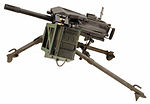Tunisian Army
This article includes a list of general references, but it lacks sufficient corresponding inline citations. (January 2015) |
| Tunisian Army | |
|---|---|
| Arabic: جيش البر التونسي, romanized: Jaîsh el-Barr et'Tunsi | |
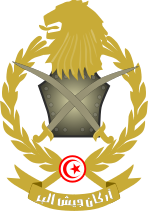 Seal of the Tunisian Land Army | |
| Founded | 1831 |
| Country | |
| Size | 90,000-45,000 active personnel and 20,000-60,000 reserves (estimation) |
| Part of | Tunisian Armed Forces |
| HQ | Tunis |
| Nickname(s) | TAF |
| Engagements | Bizerte Crisis Yom Kippur War Battle of Wazzin Chaambi Operations Battle of Ben Guerdane |
| Commanders | |
| Commander | Brigadier General Ismaïl Fathali[1] |
The Tunisian Land Army is the ground component of the Armée nationale tunisienne. The Land Forces Command is located in Bizerte. The TAF itself was created on June 30, 1956.
The Land Army is the largest service branch within the Tunisian Armed Forces and has a dominant presence in the current General Staff. It is estimated to number around 90,000, in addition to 60,000 reservists for a total of 150,000 strong.
The modern army was created in the 1830s. It has seen substantive combat on one occasion: against France during the 1961 Bizerte crisis. The mission of the Tunisian army is to defend the country against any foreign attack, to allow the development of a diplomatic counterattack and encourage the involvement of the United Nations, protect Tunisian nationals around the world and participate in peacekeeping missions.[citation needed]
History
During the Beylical period


The modern Tunisian army was formed in 1831 by Al-Husayn II ibn Mahmud.
The first battalions of the regular modern Tunisian army were created at the same time as the reform of the Ottoman army and after the French conquest of Algeria in 1830.
At the initiative of Minister of Hussein Bey II, Mamluk Shakir Saheb Ettabaâ, a battalion of Tunisians was established in Tunis in January 1831. The next year, another battalion was raised, composed mainly of Sahelians and based in Sousse. Soldiers and officers were trained, equipped and dressed in European fashion, like the first regiments of the Ottoman army after the reforms of Sultan Mahmud II which followed the removal of the Janissary Corps. Ahmed Bey I built on the initial reforms of the reign of his uncle, Hussein Bey II and initiated more extensive changes in both the Tunisian army and state.
Early structure
By 1855 the Tunisian army was divided into 7 infantry brigades spread throughout the country as listed below. Each was under the command of an Amir Liwa (Brigadier-General). From 1864 an Amir Oumar (General of Division was appointed). The numbers of each brigade varies from 1 000 to 2 000 men at different times.
- 1st brigade permanently stationed in Tunis since 1831;
- 2nd Brigade based in Sousse since 1832;
- 3rd Brigade based in Monastir;
- 4th Brigade based in Kairouan;
- 5th Brigade: formed part of the mhalla (a bi-annual mobile military column that was deployed through the back country of Tunisia);
- 6th Brigade : formed part of the mhalla;
- 7th Brigade based in El Ghar Melh (Porto Farina).
Also available from 1835 to 1860 were 4 artillery brigades (topjiya) of 1000 men each, distributed as follows:
- 1st Brigade in Tunis and Bardo since 1831;
- 2nd Brigade at La Goulette;
- 3rd Brigade distributed in the forts of the country (mainly Bizerte, Monastir, Sfax, Sousse Tabarka);
- 4th Brigade distributed in the high country.
The Army also had several Tunisian irregular regiments made up of Berber tribal levies (or Zouaoua mkhaznia) spread across the country. The full strength of these irregular units reached up to 40,000 infantry and cavalry. They were based mainly in barracks at Kef, Nefza and Tunis, and were commanded by Turkish Mamluks. When the need for a regular cavalry regiment (spahis) arose, Ahmed Bey I created one regiment in 1850, based in Manouba.
Fortifications


The country was surrounded by 110 fortresses garrisoned by detachments ranging in strength from 50 to 200 men. These comprised infantry and some artillery. They were responsible for ensuring the safety of cities, borders and coasts, the latter under the authority of the Ministry of the Navy. These forts were also used as residences by senior officials and governors, as well as serving as prisons or granaries and depots for military supplies such as gunpowder and ammunition. Every city and large village had one of these forts.
|
The Kasbah of Tunis, fortress and former residence of the Bey of Tunis, had a special status. Inherited from the Hafsid period, it was refurbished and enlarged by the Ottomans becoming their center of power. It could accommodate up to 4,000 Ottoman troops together with their weapons and equipment. It also housed the apartments of the Dey and senior officials of the Turkish troops from Tunis plus some departments of the Chancery. It was transformed into barracks by the French troops during the Protectorate and razed after Tunisian Independence.
Military Industries
Hammouda Pacha Bey was the first leader to give the country a military industry; with the creation of a modern cannon foundry in 1810; at Hafsia in the heart of the Medina of Tunis. The foundry was small but provided most of the guns required for Tunisia's small navy guns and proved quite effective according to the commentators of the time. However, to ensure the provision of equipment for the new Tunisian army, Ahmed Bey I provided the country with more modern factories on the European model from about 1840:
- a clothing factory in Tebourba which employed 400 workers. These included 48 skilled engineers of whom four were French. It used machines imported from England, under the authority of H.H. Prince (Amir) Mahmoud Ben Ayad of Djerba.
- two tanneries in Mohamedia within the walls of the Kasbah, employing which workers from the Tunisian handicraft industry;
- a second cannon foundry located on the Bardo road, in addition to that of the existing Hafsia plant with its European machinery. The two factories provided the guns required for a fully equipped artillery regiment, without the need to import any parts ;
- a factory of small arms in the barracks of Sidi Ismail in Tunis, where craftsmen work Tunisian corporations even if the quantities produced and the quality of guns are weak;
- several saltpeter mines operating in Gafsa supplying Téboursouk and Béja;
- two gunpowder plants in the Kasbah of Tunis and El Jem;
- a large modern flour mill located in Djedeida to ensure the food needs of the military in Dabdaba, near the Kasbah of Tunis. This complex included a bakery and an oil mill with hydraulic presses.
Around 1865 many of these plants were dismantled or abandoned during a financial crisis.
Instruction
In 1840 a military school called the Ecole Polytechnique was established in the Bardo Palace . Several instructors were French and Italians teaching science and military technology. The school staff also included several professors from the Zitouna University. The reformer Mahmoud Kabadou taught Arabic. The school was closed in the aftermath of the Mejba revolt in 1864, for financial reasons.
During the French occupation
During the period of the French Protectorate (1881-1956), Tunisians were recruited in significant numbers into the French Army, serving as tirailleurs (infantry) and spahis (cavalry). These units saw active service in Europe during both World Wars, as well as in Indo-China prior to 1954. The only exclusively Tunisian military force in existence under the French administration was the Beylical Guard.
After Tunisian Independence
On 21 June 1956 the transfer of about 9,500 Tunisian soldiers who had served in the French army and the Beylical Guard, made possible the speedy establishment of a combined arms regiment. The necessary equipment was made available to the young state from French and other sources. Of this number 25 officers, 250 warrant officers and 1,250 soldiers were veterans of the French army. On 30 June 1956 the new national Tunisian army was officially established by decree. The integration of the Beylical Guard, the induction of conscripts performing their military service as mandated in January 1957, and the recall of reservists enabled the army to expand from three to twelve battalions numbering 20,000 men in 1960. Approximately 60% of forces were used for border patrol and surveillance duties. The Tunisian army experienced combat for the first time in 1958; against French units crossing the southern border in pursuit of Algerian FLN fighters. However, the main battle experience of the Tunisian army, since its creation, occurred during the Bizerte crisis, when over 600 Tunisian soldiers were killed in combat against French forces.
Tunisia has contributed military forces to United Nations peacekeeping missions, including an army company to UNAMIR during the Rwandan Genocide. In his book Shake Hands with the Devil, Canadian force commander Roméo Dallaire gave the Tunisian soldiers high credit for their work and effort in the conflict and referred to them as his "ace in the hole". From 1960 the Tunisian army has participated in the following missions:
- Congo (1960–1963): 2,261 troops (1,100 from 1962) involved the replacement of the Belgian colonial army;
- Ethiopia-Eritrea (1977–1978);
- Western Sahara (1991–1997): 9 officers go there as observers of the cease-fire between Morocco and the Polisario Front;
- Cambodia (1992–1993): a contingent of 850 men participating in the disarmament of armed groups, protect refugees and treats more than 10,000 Cambodians. Sixty more men involved in the UN mission in that country;
- Somalia (1993–1994): soldiers provide security for UN facilities while doctors provide care to the population;
- Rwanda (1993–1995): 60 men are part of the African observers at the beginning of the Civil War. In 1994, a contingent of 826 soldiers deployed to the northwest of the country; In his written account of the Rwandan Genocide; Shake hands with the devil, Canadian General Romeo Dallaire gave the Tunisian UNAMIR-contingent extensive credit for their skills and efforts in the conflict, referring to them as his "ace in the hole".[citation needed]
- Burundi (1994);
- Haiti (1994–1995);
- Namibia (1994–1997);
- Comoros (1997–1998);
- Kosovo (1999);
- Democratic Republic of Congo (2000 -): 27 officers working there as observers and more than 200 soldiers provide security of the headquarters of UN command and personalities on the ground.
1,545 Tunisian soldiers have received United Nations medals for serving a minimum of 90 days as members of one or another United Nations peacekeeping missions.
During the 2011 Libyan Civil War, Tunisian forces, mostly border guards, saw some limited action when fighting between Libyan rebels and loyalist soldiers spilled over the border and clashes ensued between the Libyan Army and the Tunisian Army, resulting in at least one Tunsian civilian being injured by a Libyan rocket.
National service
The Tunisian army is in part a conscript army. Young men are called for military service at the age of twenty years, as nominally women have been since March 2003.[citation needed] Having completed their active service both conscripts and volunteers pass into the reserve until they reach the age of 35. Relatively generous pensions and salary scales have ensured that voluntary enlistment of long serving regulars is able to be maintained at about a third of the army's total manpower.
Conscripts undertaking military service are required to serve for one year. However extensive deferments on educational and family grounds mean that only between 25 and 30% of eligible males actually undertake their full national service. Because the number of available 20-year-olds exceeds the requirements of the army, a system of selective service involving the drawing of lots has been introduced.[2]
Army command and organisation
Following the Tunisian Revolution, the army strength increased up to 80,000 men in order to face the new security challenges. However the organisation remains mainly the same compared to the pre-revolution one. Most noticed change is the adding of an Intervention Battalion in each of the three mechanized infantry Brigade. These new battalions mostly focused on anti-terror fighting was seen during 61st army anniversary parade [3]
Main Tunisian Army formations are as follows :
- 1st Mechanized Infantry Brigade (Gabès, South East)
- 11th Mechanized infantry battalion (using M113 APC)
- 12th Mechanized infantry battalion (using Otobreda 6614)
- Tank battalion (using M60 Patton)
- Motorized intervention battalion (using Jeep J8)
- Field artillery battalion (using M198 howitzer)
- 51st Antiaircraft battalion (using M-48 Chaparral)
- Reconnaissance compagny (using AML-90)
- Anti-tank compagny (using BGM-71 TOW and MILAN)
- 2nd Mechanized Infantry Brigade (Béja, North West)
- 13th Mechanized infantry battalion (using M113 APC)
- 14th Mechanized infantry battalion (using Otobreda 6614)
- Tank battalion (using SK-105 Kürassier)
- Motorized intervention battalion (using BMC Kirpi)
- Field artillery battalion (using M198 howitzer)
- 52nd Antiaircraft battalion (using M-48 Chaparral)
- Reconnaissance compagny (using AML-90)
- Anti-tank compagny (using BGM-71 TOW and MILAN)
- 3rd Mechanized Infantry Brigade (Kairouan, Center)
- 13th Mechanized infantry battalion (using M113 APC)
- 14th Mechanized infantry battalion (using Otobreda 6614)
- Tank battalion (using M60 Patton)
- Motorized intervention battalion (using HMMWV)
- Field artillery battalion (using M198 howitzer)
- 53rd Antiaircraft battalion (using M-48 Chaparral)
- Reconnaissance compagny (using AML-90)
- Anti-tank compagny (using BGM-71 TOW and MILAN)
- Saharian territory forces group (South West)
- 1st Regiment of Saharian territory infantry (Remada, Extreme South, using Ejder Yalçın)
- 2ns Regiment of Saharian territory infantry (Kebili, South West, using Toyota Land Cruiser 76)
- Army Special forces Group, S.F.G (El Aouina, Capital suburbs)
- Police Military Group (Tunis, Capital)
- Armored Engineer battalion (Kairouan, center)
Ranks
The Tunisian Army is composed of the corps of officers, NCOs and other ranks.
Officers
| Rank Type | Generals | Superior officers | Subordinate officers | |||||||
|---|---|---|---|---|---|---|---|---|---|---|
| NATO Code | OF-9 | OF-8 | OF-7 | OF-6 | OF-5 | OF-4 | OF-3 | OF-2 | OF-1 | |
| Insignia |  |
 |
 |
 |
 |
 |
 |
 |
 |
 |
| Arabic | فريق أول | فريق | أمير لواء | عميد | عقيد | مقدم | رائد | نقيب | ملازم أول | ملازم |
| Title | Army Corps General | Divisional General |
Brigadier General |
Senior Colonel | Colonel | Lieutenant Colonel |
Major | Captain | First Lieutenant |
Second Lieutenant |
| Abbreviation | ACG | GEN | BG | SC | COL | LTC | MAJ | CPT | 1LT | 2LT |
NC Officers and Enlisted soldiers
| Rank Type | Non-commissioned officer | Enlisted soldiers | |||||||
|---|---|---|---|---|---|---|---|---|---|
| NATO Code | OR-9 | OR-8 | OR-7 | OR-6 | OR-5 | OR-4 | OR-3 | OR-2 | OR-1 |
| Insignia |  |
 |
 |
 |
 |
 |
 |
 |
 |
| Arabic | وكيل أعلى | وكيل أول | وكيل | عريف أول | عريف | رقيب أول | رقيب | جندي أول | جندي |
| Title | Senior-Adjutant | Master-Adjutant | Adjutant | Master-Sergeant | Sergeant | Master-Corporal | Corporal | Soldier 1st class |
Soldier 2nd class |
| Abbreviation | SAD | ADC | ADJ | MSG | SGT | MCP | CPL | 1SD | 2SD |
Missions
Development support
The activities include development of trails, housing, the connection of several residential groups to drinking water systems and electricity, building bridges and drilling wells. The army also contributes to the achievement of the university campus of Gafsa and the construction of the airport of Gabes.
Higher education
Military higher education in Tunisia is based on the organization of engineering education in the country and therefore the French model.
Young cadets are allowed for two years in a preparatory military school academies (Bizerte, Sousse and Sfax), where science education is modeled on the faculties of science, legal and political sciences and preparatory institutes studies of local engineers. The cadets receive military training in parallel together. Next, the cadets are referred to training abroad or a national military academies:
- Fondok Jedid Military Academy (Land Army);
- Menzel Bourguiba Naval Academy (Naval Force);
- School of Aviation Borj El Amri (Air Force).
After an internship in service as second lieutenants, cadets leaving lieutenants.
Tunisia also has a captain's school, staff's school, school of war and an institute of national defense. The army has also developed since the early 1970s, a vocational training system benefiting both the calls and young civilians who wish to undergo training in the army.
Army equipment
Small arms
Artillery
| Name | Image | Type | Number | Origin | Notes |
|---|---|---|---|---|---|
| Towed Artillery | |||||
| M-198 howitzer | 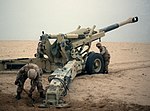
|
155mm towed howitzer | 57[5] | Main Artillery piece equiping 3 artillery battalions each attached to an Infantry Mechanized Brigade Heavily deployed during Chaambi Operations Delivered on 1989 | |
| M-101A1 howitzer | 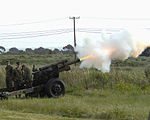
|
105mm towed howitzer | 10-48[5] | Probably never commissioned in Tunisian Army service following an inconclusive test Delivered on 1981 | |
| Mortars | |||||
| M30 mortar | 
|
107mm heavy mortar | 144 | 78 tower + 36 mounted in mortar carriers M106A2 as self-propelled heavy mortars | |
| M29 mortar | 
|
81mm medium mortar | 96 | ||
Former artillery equipment includes:
- 30 Mle 1950 BF-50 155mm towed howitzer (France), delivered on 1960 (no longer in service)
- 30 M114A1 155mm towed howitzer (USA), ex-US, delivered on 1965 (no longer in service)
- 48 M108 105mm self-propelled howitzer (USA),ex-US, delivered on 1968 (no longer in service)
Anti-tank weapons
| Name | Image | Type | Caliber | Origin | Notes |
|---|---|---|---|---|---|
| Anti-tank guided missile | |||||
| BGM-71 TOW | 
|
Anti-tank missile] | 152 mm with warhead | Mounted on HMMWV with some assumed to equip M901 ITV thus no evidence to confirm it. Number of launchers is unknown, but considering the army organisation should be around 36. 454 missiles delivered on 1982 and 180 missiles delivered on 2006[5] | |
| MILAN | File:Le-milan.jpg | Anti-tank missile | 115 mm with warhead | Number of launchers is unknown. 100 missiles delivered on 1981 and 40 missiles delivered on 1997 | |
| Recoilless guns | |||||
| M40 recoilless rifle | File:M40 Recoilless gun of the Tunisian army.jpg | Recoilless rifle | 105 mm | 70 guns in serves. | |
| Shoulder Launched Anti-tank Rocket | |||||
| LRAC F1 | File:Tunisian soldier firing LRAC F1.jpg | Rocket-propelled grenade launcher | 89 mm | Unknown number of launchers, could be around 600 | |
Former anti-tank equipment includes:
- 80 SS.11 ATGM launcher (France)
- 300 M20 "Super Bazooka" 3.7 inch/94mm Light ATRL (USA)
- 140 M18 57mm recoilless rifle (USA)
Anti-aircraft weapons
| Name | Image | Type | Number | Origin | Notes |
|---|---|---|---|---|---|
| Surface-to-air missile and Early-warning radar | |||||
| M-48 Chaparral | 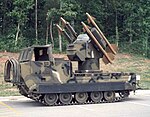
|
Surface-to-air missile] | 46 | 26 M-48 launchers and 354 MIM72C missiles delivered on 1979 311 MIM72F Charparral missiles delivered on 1983 20 M-48 launchers, 300 MIM72C and 300 MIM72F Charparral missiles delivered on 2002 (second hand; aid)[5] | |
| RBS-70 Bofors | 
|
Surface-to-air missile | 60 | Delivered on 1981 including 300 missiles | |
| Giraffe 40 radar | 
|
Medium-Short rang radar | 12 | Delivered on 1981 | |
| Anti-aircraft guns | |||||
| Zastava M55 | 
|
3x20mm Anti-aircraft guns | 105 mm | 100 guns in service | |
Not confirmed equipment:
- 24 Skyguard AD System\Ammon 4x Aspide SAMs (Italy) - second hand on order from Egypt
- 24 Oerlikon GDF-002 2× 35mm AAGs (Swiss) - second hand on order from Egypt
- 18 Sinai-23 AD System 4×Strela 2 MANPAD launchers and ZU-23-2 23mm twin-mounted AAG on M113A2) (Egypt/USSR/USA) - second hand on order from Egypt
- 24 M163 VADS 20mm self-propelled anti-aircraft gun (USA) - second hand on order
- 2-4 MIM-23 Hawk medium range anti-air missile (USA) - second hand on order
- 18-24 AN/TWQ-1 Avenger medium range anti-air missile (USA) - second hand on order
- 15 Type 55 37mm towed anti-aircraft gun (China)
- 15 Type 65 2x 37mm towed anti-aircraft gun (China)
- 150 Strela 2 MANPAD launcher (USSR)
Former anti-aircraft equipment includes:
- 16 M42 Duster twin-mounted Bofors 40 mm self-propelled AAG (USA/Sweden) 8 delivered on 1968 and 8 delivered on 1972, all second hand; aid
Tanks
- 59 M60A3 Patton 105mm main gun main battle tank (USA)
- 30 M60A1 Patton 105mm main gun main battle tank (USA)
- 26-30 M48A5 Patton 105mm main gun main battle tank (USA) (most probably out of active service)
- 55-80 SK-105 Kürassier 105mm main gun light tank/tank destroyer (Austria) (most probably out of active service)
Reconnaissance
- 18-36 EE-9 Cascavel 90mm main gun 6×6 ARV (Brazil) (used by The Tunisian National Guard)
- 24 Alvis Saladin 76mm main gun 6×6 ARV (UK) (possibly no longer in service)
- 40 Panhard AML 90 90mm main gun 4×4 ARV (France)
- 10 Panhard AML 60 60mm mortar 4×4 ARV (France)
- 18 EE-3 Jararaca 4×4 ARV (Brazil)(used by The Tunisian National Guard)
APC/IFVs
- 35-100 M901 ITV 2 × BGM-71A\C Improved TOW ATGM launcher (USA)
- 140-334 M113A1/M113A2 APC (USA)
- 56 M106A2 M30 4.2 inch/107mm heavy mortar APC (USA)
- 66 M125A2 M29A1 81mm medium mortar APC (USA)
- 24 M577A2 APC (USA)
- 300-500 Humvee with Mk 19 40mm AGL 4×4 APC (USA)
- 150 Fiat 6614C 4×4 APC (Italy)
- 18-36 EE-11 Urutu 6×6 APC (Brazil)
- 110 Fahd 240/280 4×4 APC (Egypt) (on order)
- 20 Cadillac LAV V150 Commando 4×4 APC (USA) - reported
- 10 VXB-170 4×4 APCs (France)
- 200 BMC Kirpi MRAP (Turkey)
- 70-140 nurol Ejdar MRAP (Turkey)
- 9 VURAN 4×4 Tactical Wheeled Armored Vehicle (Turkey)
- 4 Bastion APCs received in 2016, supplied via U.S. DoD.
Logistics and engineering equipment
- Bailey bridges (UK)
- 26 M88A2 Hercules ARV (USA)
- 5 Greif ARV (Austria)
- 5 Pioner CEV (Austria)
- 4 M728 CEV (USA)
- D-9 Bulldozers (USA)
- Zodiak boats (France)
AFV transporters
- HET M1000 (USA)
Utility vehicles
- M151A2 MUTT 4×4 (USA)
- Land Rover Defender 4×4 (UK)
- Mercedes-Benz Unimog U-4000 (Germany)
- Mercedes-Benz Unimog U-5000 (Germany)
- M35A2 cargo truck (USA)
- M939 cargo truck (USA)
- 56 M49 tanker truck (USA)
Radar
Other equipment
- Global Positioning System (USA)
- Night vision goggles (USA)
- SPECTRA helmet (France)
- PASGT helmet (USA)
- Bose headphones (USA)
- Motorola radio systems (USA)
- Red dot sights (USA) (UK) (France)
- Optical sights (USA) (UK) (France)
- Interceptor body armor (USA)
References
- ^ (in Arabic) defense ministry Archived 2013-07-18 at the Wayback Machine
- ^ Keegan, John. World Armies. p. 713. ISBN 0-333-17236-1.
- ^ https://www.youtube.com/watch?v=ZvdPSGTFLhA&feature=emb_logo
- ^ Cite error: The named reference
jones2009was invoked but never defined (see the help page). - ^ a b c d "Trade Registers". armstrade.sipri.org.











